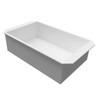Scientific Plastics
Secondary Spill Containment Tote, Polyethylene, 19" L x 5" H
- Part Number:
- SCIP-ST1908-500
- Lead Time:
- 5-7 days
- Shipping:
- FREE SHIPPING on most orders over $50*
- Quantity:
- each
- Country of Origin:
- Made in the USA
Bulk discount rates
Automatically save when you buy in bulk.
| Buy 6 - 10 | and get 10% off |
| Buy 11 or above | and get 15% off |
Description
After spill trays, shelf totes are the most versatile spill containment product for the lab. Safely transport and store chemicals; use a shelf tote to collect chemicals before, during and after class; or simply use the tote to organize a cart or in a cabinet. Made from one-piece molded polyethylene, these shelf totes are acid resistant, impact resistant and have coved interior corners for easy clean up.
- Choose from three standard sizes
- 19" L x 8" W x 5" H (12 liter)
- 19" L x 11" W x 5" H (17 liter)
- 19" L x 16" W x 5" H ( 24 liter)
- 100% polyethylene construction
- Acid resistant / highly chemical resistant resin
- One-piece design
- Thick, impact-resistant material resists breakage
- Interior corners are coved for easy cleaning
- Dishwasher safe
- Natural white color
- Made in the USA
Complies with the following regulations (when sized correctly):
Occupational Safety and Health Administration, OSHA 1910.1450
(b) Stockrooms/storerooms ... Chemicals which are highly toxic ... should be in unbreakable secondary containers…..A spill control policy should be developed and should include consideration of prevention, containment, cleanup and reporting.
Environmental Protection Agency, EPA 264.175:
(a) Container storage area must have a containment system that is designed and operated in accordance with paragraph (b).
(b) A containment system must be designed and operated as follows: (1) a base must underlie the containers which is free of cracks or gaps and is sufficiently impervious to contain leaks, spills.
(3) The containment system must have sufficient capacity to contain 10% of the volume of containers or the volume of the largest container whichever is greater.
1910.1450 Appendix A - National Research Council Recommendations Concerning Chemical Hygiene in Laboratories
5. Institute a Chemical Hygiene Program --A comprehensive chemical hygiene program is required. It should be designed to minimize exposures, injuries, illnesses and incidents. There should be a regular, continuing effort that includes program oversight, safe facilities, chemical hygiene planning, training, emergency preparedness and chemical security. The chemical hygiene program must be reviewed annually. and updated as necessary whenever new processes, chemicals, or equipment is implemented. Its recommendations should be followed in all laboratories.








